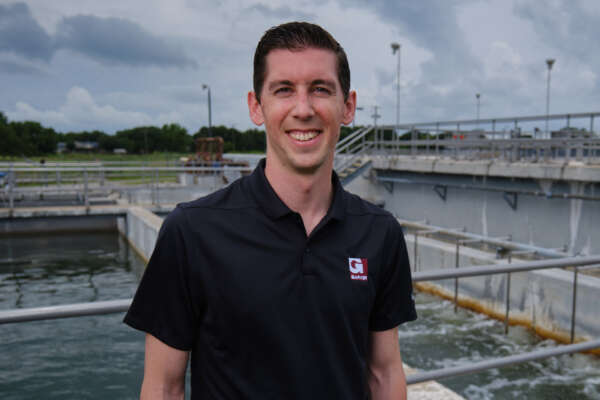Peracetic acid disinfection is proven reliable, effective, and within regulation
We coordinated with TCEQ on a full-scale pilot test of peracetic acid disinfection at the Hutto South WWTP.

Consultants, engineers, and municipalities in Texas have, as a precaution, avoided using peracetic acid (PAA) as a disinfectant, concerned that adding organic material to treatment would lead to organic material in excess of the 10 mg/L limit and to resulting permit violations.
Our pilot test of the first PAA disinfection system in Texas, in partnership with the City of Hutto and in coordination with the Texas Commission on Environmental Quality (TCEQ), however, demonstrates that PAA is a safe, effective alternative to traditional disinfectants, won’t compromise regulatory compliance, and can be used as a standalone or supplementary disinfectant.
Background
The Hutto South Wastewater Treatment Plant (WWTP), owned by the City of Hutto and operated by the Brazos River Authority (BRA), treats municipal wastewater before discharging it into Brushy Creek.
The plant currently operates at a capacity of 2.5 million gallons per day (MGD) and has relied on a multi-channel microwave ultraviolet (UV) disinfection system for its disinfection process. It’s undergoing an expansion - to 6 MGD - to meet increasing wastewater demands in the region, and that expansion includes upgrades to the UV system.
The age of the existing UV equipment made obtaining essential UV system components, such as ballasts and lamps, challenging. To address this challenge and improve system performance and reliability, the City engaged Garver to evaluate alternatives for a rapidly deployable temporary system that would help them continue meeting disinfection requirements while a new, expanded UV facility was being constructed.
Garver evaluated multiple options, including temporary pad-mounted UV trailers and a PAA disinfection system. PAA is a fast-acting and powerful disinfectant composed of acetic acid (vinegar) and hydrogen peroxide (C₂H₄O₃). When dissolved in water, it breaks down into peracetate ions and hydrogen peroxide, both of which contribute to its antimicrobial properties. With an oxidation potential similar to chlorine dioxide and sodium hypochlorite, PAA disrupts the outer membranes of microorganisms, causing cell rupture and subsequent death.
After careful evaluation, PAA emerged as a practical, efficient, and environmentally responsible choice for temporary disinfection at the South WWTP because of these advantages:
- Regulatory Compliance: effectively meets water quality standards without leaving an oxidant residual that requires quenching before discharge
- Safety: easier and safer to handle compared to chlorine-based disinfectants
- Environmental Benefits: produces no harmful halogenated disinfection byproducts (DBPs)
- Storage and Management: available in stable, bulk solutions that are easy to store and manage
- Cost-Effectiveness: easily retrofitted into existing systems with minimal modifications, making it a low-maintenance and economic solution
- Rapid Implementation: ideal for situations requiring quick deployment
- Reduced Environmental Footprint: provides effective disinfection while reducing ecological impacts
While PAA offered advantages, it also introduced unique challenges when used for disinfection in a WWTP. PAA can contribute carbonaceous biochemical oxygen demand (BOD) into the wastewater effluent during disinfection. Additionally, overdosing can significantly affect effluent pH levels, potentially impacting downstream processes.
To address these concerns, we conducted a 30-day full-scale testing cycle under TCEQ-approved testing protocols.
The full-scale pilot test aimed to:
1. Test different PAA dosages to determine the optimal PAA dosage for effective E. coli reduction
2. Monitor wastewater parameters to confirm that PAA residuals would not impact on the receiving water body
3. Monitor wastewater parameters to confirm that PAA addition would not cause an exceedance of any discharge parameters outlined in the existing TPDES permit

Pilot Test
The PAA system was installed by Enviro Tech, an Arxada company, in February 2024. The system included three Qdos 60 peristaltic chemical feed pumps (15 gallons per hour each) housed in a 316 stainless steel enclosure for outdoor operation. A stainless steel secondary containment tank (125% capacity for two totes) provided spill protection, while an additional roll-top containment system housed two extra 300-gallon totes for redundancy.
Garver engineers, in collaboration with BRA plant operators, conducted a full-scale pilot test from February to March. During this 30-day period, key wastewater parameters were monitored while the PAA system operated for supplemental disinfection. PAA was dosed upstream of the UV system, which remained in operation throughout the test. The monitored wastewater parameters included:
- BOD concentrations
- pH values
- Average and peak flows
- Contact time
- PAA dose and residual concentrations
- Disinfection efficiency (E. coli destruction)
- Hydrogen peroxide (H2O2) concentrations
The PAA disinfection system was installed adjacent to the Post-Equalization (PEQ) basin. A stainless-steel injection line was routed from the PAA chemical station to the inlet pipe of the PEQ basin. There were three sampling locations S1, S2, S3:
- S1 – Collected from the top of the Sequence Batch Reactor (SBR) basin before effluent was transferred to the PEQ basin, serving as a baseline to assess the impact of PAA addition
- S2 – Collected from the PEQ basin effluent before it entered the UV channels to evaluate the effectiveness of PAA disinfection prior to UV treatment
- S3 – Collected from the Parshall Flume after the UV Channels to evaluate the performance of PAA with the existing UV system
Wastewater samples were collected daily, Monday through Friday, from S1, S2 and S3 to assess the impact of PAA addition into the South WWTP on disinfection performance. The PAA system remained operational over the weekends to ensure continuous treatment.
PAA concentrations were measured with a HACH DR900 spectrometer using the HACH Method 4500. The standard methods used during the full-scale testing are shown in Figure 1.
During the full-scale testing period, four PAA dosages ranging from 1 mg/L to 2.50 mg/L were applied at the PEQ basin to determine the optimal disinfection levels for reducing E. coli concentrations. PAA residual concentrations were continuously monitored at S2 and S3, while hydrogen peroxide (H2O2) concentrations were monitored at S3.
Challenges
During testing and full-scale operation, air bubbles in the tubing feeding PAA into the water were a challenge. Hydrogen peroxide, a component of PAA, releases oxygen gas, which can get trapped in the tubing, affecting pump calibration, and causing underdosing of PAA.
Another issue involved PAA leakage from fittings and gaskets during operation. As a strong oxidant, PAA reacts with certain materials, such as PVC, which can degrade. To prevent chemical leaks, proper compatible materials for pump heads, gaskets, seals, and fittings should be used during operation.

Results and Findings
The average PAA residual concentrations for each dosage tested during the full-scale testing period revealed that a PAA dose of 2.0 mg/L showed the best results. The PAA dose of 2.5 mg/L had a residual concentration of 0.89 mg/L which was remarkably close to exceeding permit threshold of 1.0 mg/L.
No significant changes to pH levels were observed during the testing period, and no significant changes to BOD loading were detected at PAA concentrations below 2.5 mg/L.
Hydrogen peroxide concentrations remained below 0.2 mg/L in final effluent samples.
E.coli concentrations from December 2023 and January 2024, prior to the installation of the PAA disinfection system, were compared with those measured during the full-scale testing period. Data analysis revealed that the average E.coli concentration before the addition of PAA (UV disinfection alone) was 24 MPN/100mL. After the installation of the PAA system, average E.coli concentration dropped to 7 MPN/100mL, representing a significant improvement in the plant’s disinfection capacity.
Figure 2 shows the E. coli concentrations before and after the addition of PAA. Additionally, the data showed that PAA alone inactivated 95% of the E. Coli before the UV system. The UV system further enhanced disinfection, increasing E. coli inactivation from 95% to 99%.
These key findings from the testing confirm that PAA, both as a standalone and supplementary disinfection system, is a reliable and effective disinfection solution that enhances wastewater treatment while meeting regulatory and operational standards.
For a full discussion of how our coordination with TCEQ led to Texas’ first temporary municipal discharge permit for PAA disinfection, read our article in Issue 2 of Texas WET.









Share this article